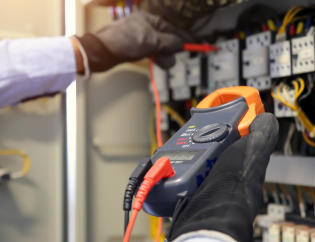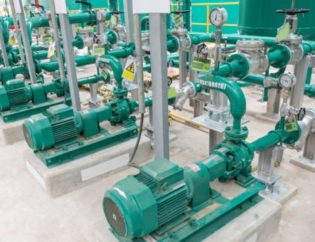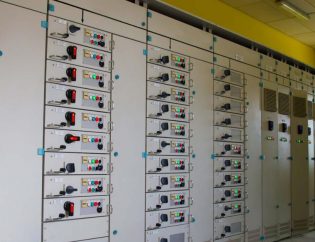What is a Contactor?
A contactor is an electrically operated switch that controls an electrical power circuit. It consists of a set of contacts that are normally open, but when a voltage is applied, the contacts close and allow current to flow through the circuit.
How it Works
The contacts in a contactor are typically made of materials that can withstand high electrical currents and are designed to operate under high loads. When a control voltage is applied to the contactor’s coil, it creates a magnetic field that pulls the contacts together, allowing current to flow through the circuit.
Applications of a Contactor
Contactors are used in various applications, such as controlling lighting circuits, heating systems, and large electric motors. They are commonly used in HVAC systems, conveyor belts, and manufacturing equipment.
Advantages:
- Contactors are designed to handle high electrical loads and are often used in industrial applications to control motors, lighting systems, and other heavy-duty equipment.
- Contactors are built to withstand harsh conditions and provide reliable operation even in challenging environments. They are also designed with safety features that prevent them from overheating or causing damage to the equipment they are controlling.
- Contactors have a simple design, consisting of a coil, contacts, and an enclosure. This simplicity makes them easy to manufacture and maintain, and they have a long lifespan.
Disadvantages:
- While contactors are designed to handle high electrical loads, they are not suitable for starting motors. Motor starters are specifically designed for this purpose, as they can handle the high inrush current that motors require to start.
- Contactors are not designed to provide overload protection, which is necessary to prevent damage to motors and other equipment in case of overload or short circuit.
- Contactors can generate electrical noise, which can interfere with other electrical equipment and cause operational problems. Shielding or filtering may be necessary to reduce or eliminate this noise.
Related blog: Soft Starter vs. Star Delta Starter
What is a Motor Starter?
A motor starter is an electromechanical switch that is used to start and stop electric motors. It consists of a contactor, overload protection, and a control circuit to initiate and stop the motor.
How it Works
The motor starter uses a control circuit that is wired to a switch or control device. When the switch is turned on, the control circuit energizes the contactor’s coil, which closes the contacts and allows current to flow to the motor. The overload protection in the motor starter is used to protect the motor from damage due to excessive current.
Applications of a Motor Starter
Motor starters, such as conveyor belts, pumps, and fans, are commonly used in applications where motors need to be started and frequently stopped. They are also used in applications where the motor must be protected from overloading, such as manufacturing equipment.
Advantages:
- Motor starters are designed to provide overload protection to prevent damage to motors and other equipment. They are equipped with overload relays that can detect overcurrent conditions and cut off power to the motor to prevent overheating and damage.
- Motor starters are built to handle high electrical loads and can control the starting and stopping of motors in industrial applications.
- Motor starters are built with safety features that prevent overheating and other issues, ensuring reliable operation even in harsh environments.
Disadvantages:
- Motor starters are not designed for high-frequency switching applications, as they can wear out quickly and cause operational problems.
- Motor starters can generate electrical noise that can interfere with other equipment and cause operational problems. Shielding or filtering may be necessary to reduce or eliminate this noise.
- Motor starters have a more complex design than contactors, with additional components such as overload relays, control circuits, and auxiliary contacts. This complexity can make them more expensive and difficult to maintain.
Related blog: All you need to know about Direct On Line (DOL) Motor Starter
Differences Between Contactor and Motor Starter
Basic Differences
The primary difference between a contactor and a motor starter is that a contactor is simply an electrically operated switch. In contrast, a motor starter includes overload protection and a control circuit.
Overload Protection
Motor starters include overload protection, which is used to prevent the motor from overheating due to excessive current. Contactors do not have built-in overload protection and are unsuitable for motor starting.
Control Circuit
Motor starters include a control circuit that is used to start and stop the motor. Contactors do not have a control circuit and are typically used in applications where another device controls the motor.
Power Circuit
Contactors are used in power circuits to switch high electrical loads on and off. Motor starters are used in power circuits to start and stop motors and provide overload protection.
Size and Rating
Motor starters are typically larger and more powerful than contactors. This is because motor starters have to handle the starting current of the motor, which can be several times higher than the normal operating current. Contactors, on the other hand, are designed to handle high electrical loads but do not have to handle the starting current of the motor.
Cost
Motor starters are typically more expensive than contactors due to the additional components, such as overload protection and a control circuit. Contactors are simpler in design and are, therefore, more cost-effective.
When to Use a Contactor or a Motor Starter
Several factors need to be considered when deciding whether to use a contactor or a motor starter. These include:
- The size and type of motor being used
- The frequency of starting and stopping the motor
- The need for overload protection
- The type of control circuit being used
Contactors are commonly used in lighting circuits, heating systems, and large electric motors. They are also used in HVAC systems, conveyor belts, and manufacturing equipment. Motor starters are typically used in applications where motors need to be started and frequently stopped, such as conveyor belts, pumps, and fans. They are also used in applications where the motor must be protected from overloading, such as manufacturing equipment.
Conclusion
In conclusion, understanding the differences between contactors and motor starters is crucial in electrical engineering. Contactors are electrically operated switches, while motor starters include overload protection and a control circuit. When deciding which one to use, several factors need to be considered, including the size and type of motor being used, the frequency of starting and stopping the motor, and the need for overload protection. By considering these factors, you can ensure that you choose the right device for your application.
Beware of using contactors for motor starting, as they do not provide overload protection, which can damage the motor or equipment. Similarly, using motor starters in applications where only a switch is required can be an unnecessary expense. It’s essential to assess the specific needs of your application and choose the device that best meets those needs.
Safety should always be the top priority when working with electrical equipment. It’s essential to follow proper safety protocols and ensure that all equipment is installed and operated correctly to avoid potential hazards.
If you need help with which device to use in your application or need assistance with installation, feel free to seek advice from a professional electrician at ECSKSA. They can guide you in selecting a suitable device and ensuring it is installed and operated safely.
Do you have a question in your mind? If so, make sure to fill out the form below!









